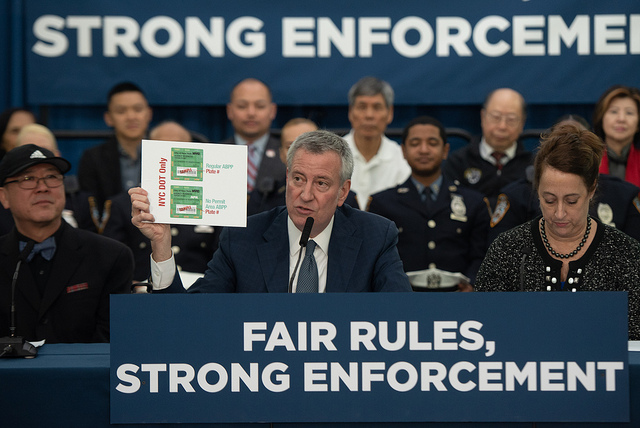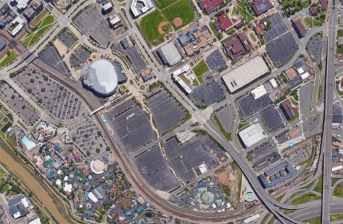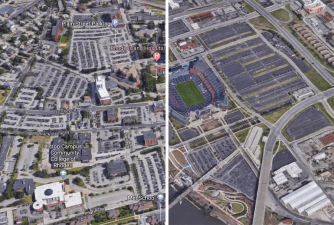De Blasio Unveils Tiny Digital Placard Pilot in Final Days


Too little? Most likely. Too late? Definitely.
Just days before the end of his tenure and almost eight years into Vision Zero, Mayor de Blasio claimed he will begin to end placard abuse in New York, unveiling a digital parking placard system that will launch in the next few days in Downtown Brooklyn.
According to the city, Traffic Enforcement Agents will use new handheld digital screeners to determine if a city-issued placard is legit for the city car on which it is affixed. The system is supposed to expand citywide by the end of next year.
At the beginning of December, the Department of Transportation told the New York Post that the agency was close to finishing a digital database of the more than 100,000 city-issued parking placards. Although somewhat unclear, the press release suggests that every paper placard in the city will be replaced by the non-transferrable, bar-code-bearing, scannable placard next year.
In theory, this shift to electronic placards, which was teased earlier in December by NYPD Transport Chief Kim Royster, will make it easier for TEAs to do one thing: crack down on city employees who park where they aren’t supposed to.
But nothing in the announcement explains why TEAs will suddenly be more interested in ticketing fellow officers or other municipal employees simply because a barcode has replaced a laminated piece of paper. Nor does it explain how this moves away from the much more informal system of placard abuse in which hand-scrawled notes, patrol books or safety vests count as legitimate reasons to park in a bus stop.
Or as journalist Katie Honan put it, “You don’t need a digitized placard reader to ticket cars using safety vests or a 2007 PBA card in the dash to avoid getting tickets.”
you don't need a digitized placard reader to ticket cars using safety vests or a 2007 PBA card in the dash to avoid getting tickets.
or to see that an expired placard from the 71 precinct doesn't absolve from getting a ticket within the confines of the 108 … https://t.co/LoUoYXFS5K
— katie honan (@katie_honan) December 23, 2021
The keepers of the seminal Placard Corruption Twitter account, which posts pictures of placard perps, shared Honan’s view.
“The overwhelming majority of what we see and post never involves any problem with validating the privileges of the placard,” said the group, which speaks anonymously because its members have been harassed by cops in the past. “They’re used in illegal places where no placard is valid. They have printed expiration dates that anybody can see has expired. There’s paraphernalia and fake placards that are so obviously bogus that you wouldn’t even know how to scan them. But they signal the right connections, so they get the ‘courtesy’ of corrupt enforcement, which de Blasio and the NYPD aren’t even pretending to address anymore.”
Of course, issues like that will no longer be Mayor de Blasio’s problem in eight days, unless he makes the unlikely decision to make the city’s chaotic curb management an issue in his expected gubernatorial run. The introduction of the electronic system is finally happening two years after the mayor announced they would be part of a crackdown on placard abuse, a promised crackdown that was also supposed to involve buying parking lots for police officers to park their personal vehicles in. That being said, it’s another opportunity to rehash the outgoing administration’s bungling of the issue, just for old time’s sake.
The mayor, who came into office promising to bring the Vision Zero program to New York City, managed to undercut the goal of bringing traffic deaths to zero by handing out 50,000 additional placards to school teachers in 2017. Ironically, that was the same year that the mayor said he was going to crack down on the problem of placard abuse. In addition to expanding the number of placards floating around the city, de Blasio never really put any heft behind his plans to curb placard abuse. In 2020, the mayor axed a NYPD and DOT unit that each existed to crack down on placard abuse, although those units issued a tiny amount of the small number of summonses even handed out for “fraudulent use of a parking permit.”
In the mean time, anyone with eyes could see police precincts where officers parked their own personal cars all over the sidewalks, or find bus stops where placard holders parked with impunity.
In some ways, the announcement is even worse than not doing anything, Placard Corruption said.
“This is the worst kind of smokescreen. It pretends to address the problem while making accountability even harder, and it wastes taxpayer money. This announcement not only deliberately avoids the problem of all the corruption with real placards, it creates another bogus excuse that beat cops will use when citizens ask them to take action against the illegal activities on our streets: They don’t have a scanner,” the group said.
Nonetheless, Department of Transportation Commissioner Hank Gutman said the program will “help strengthen enforcement and keep our streets safe.”
“The DOT has joined our sister agencies in sharing our placard data with the NYPD to help end this type of corruption,” he added.


